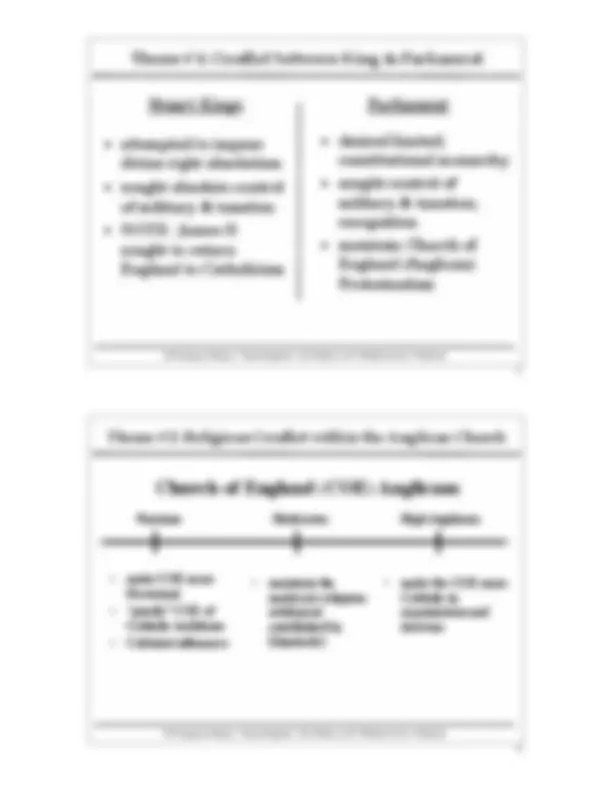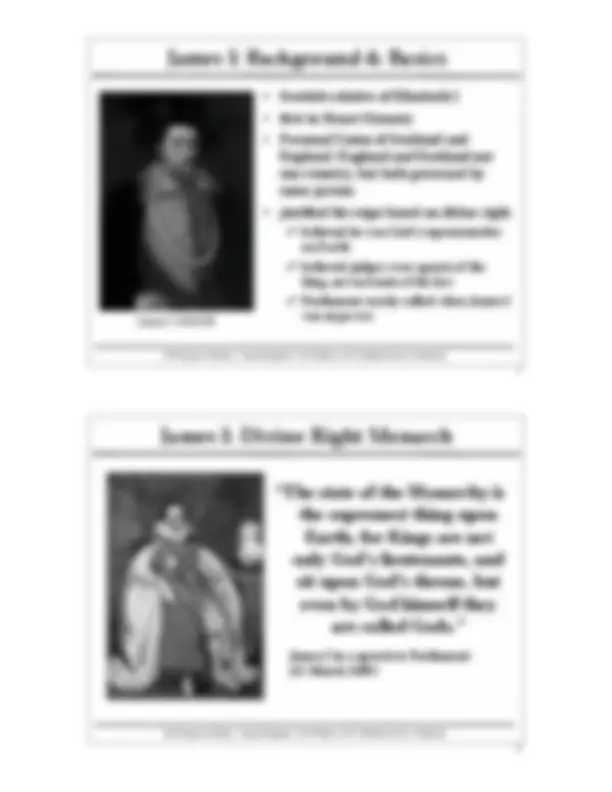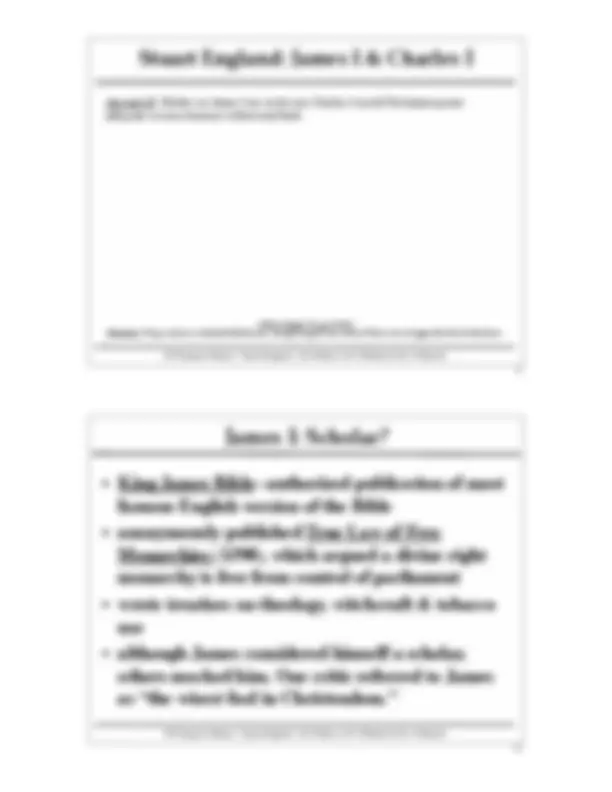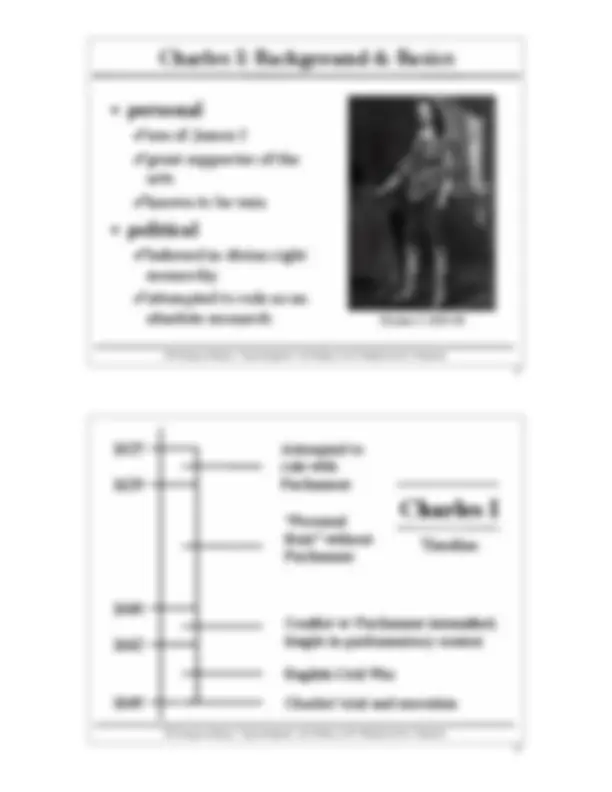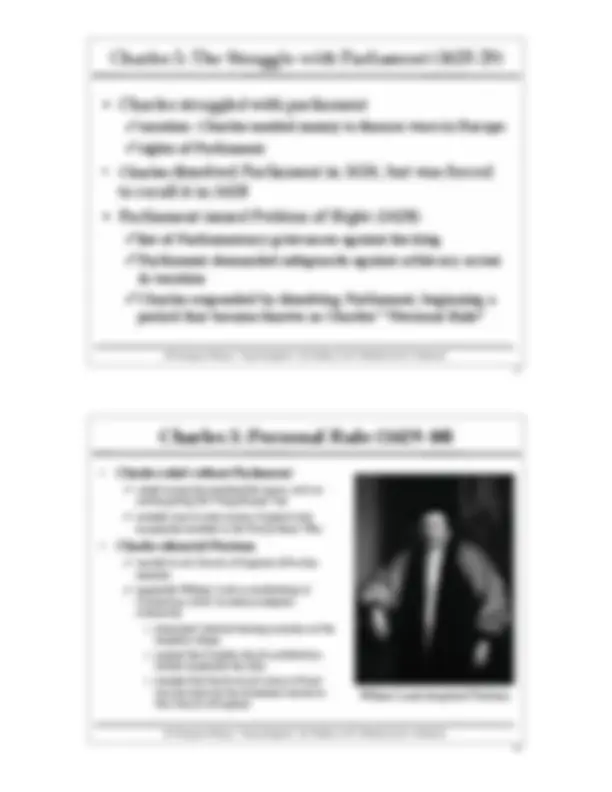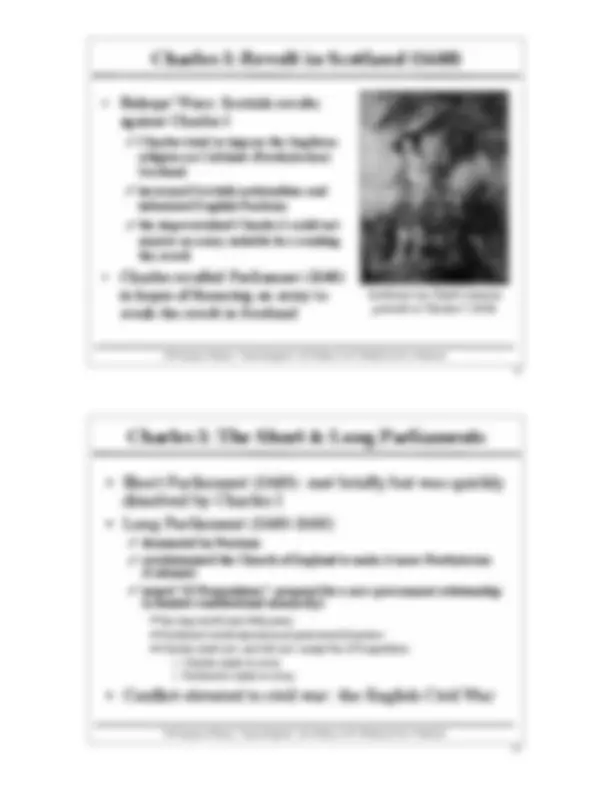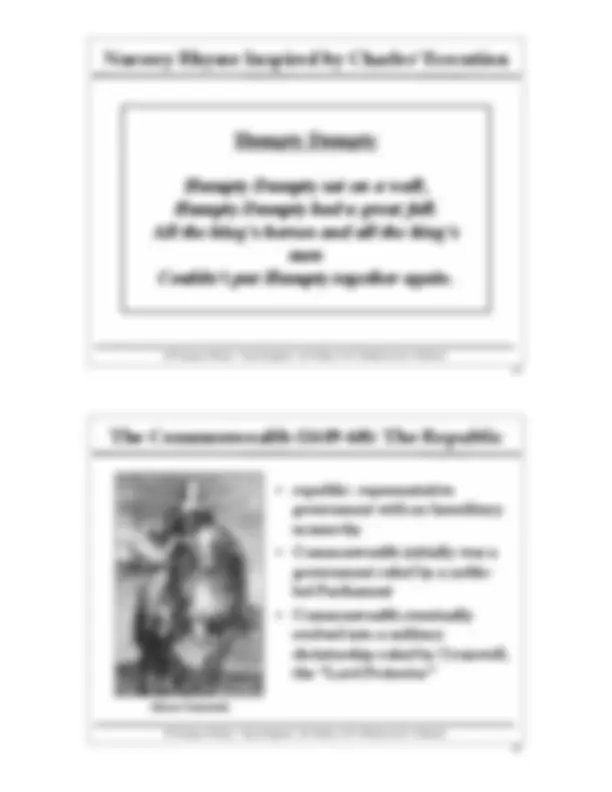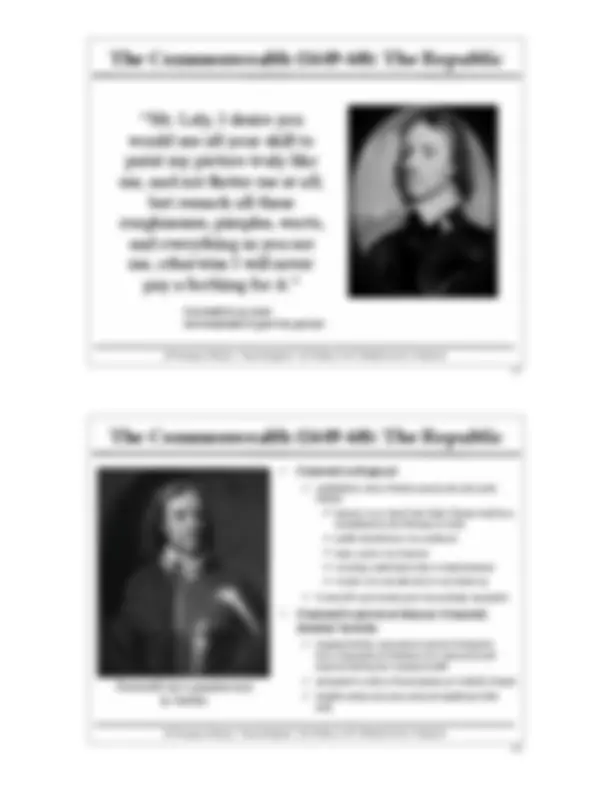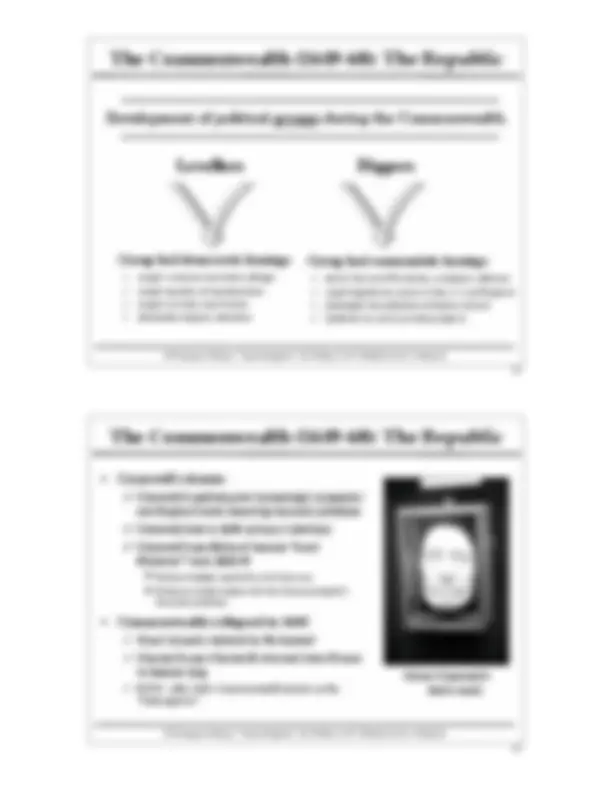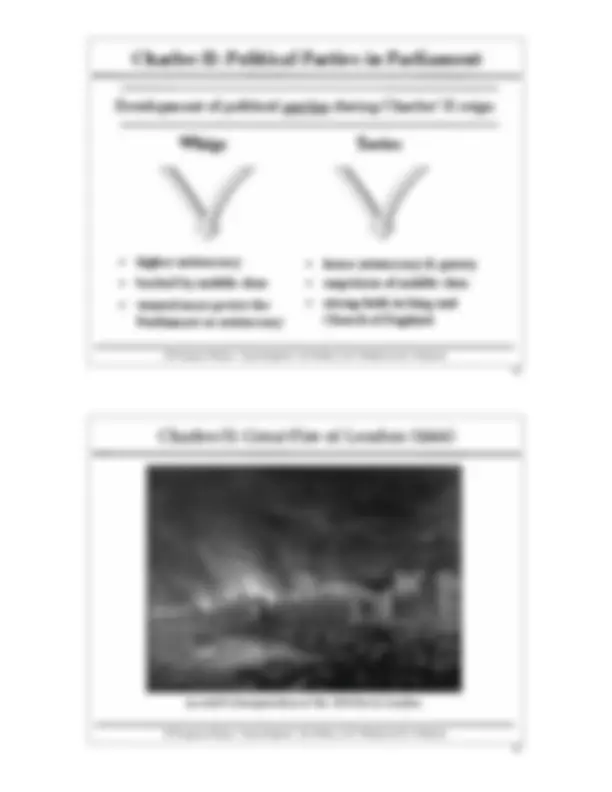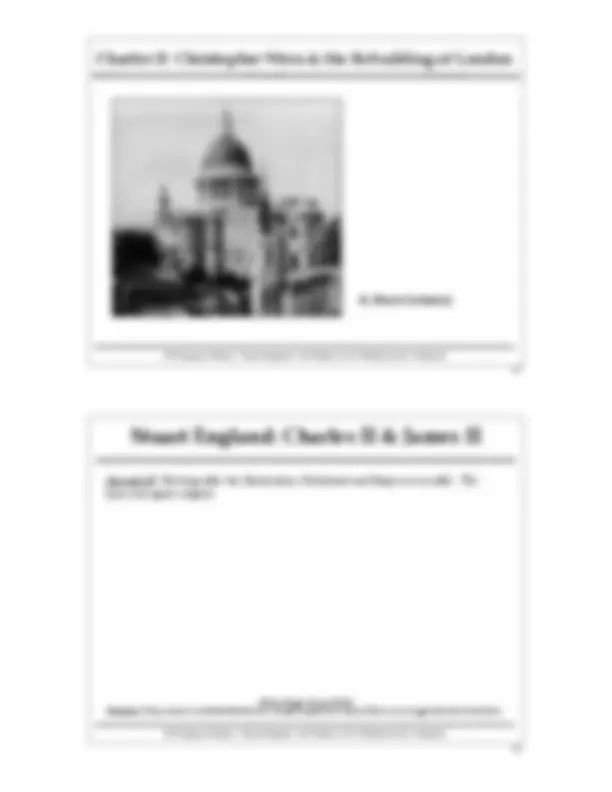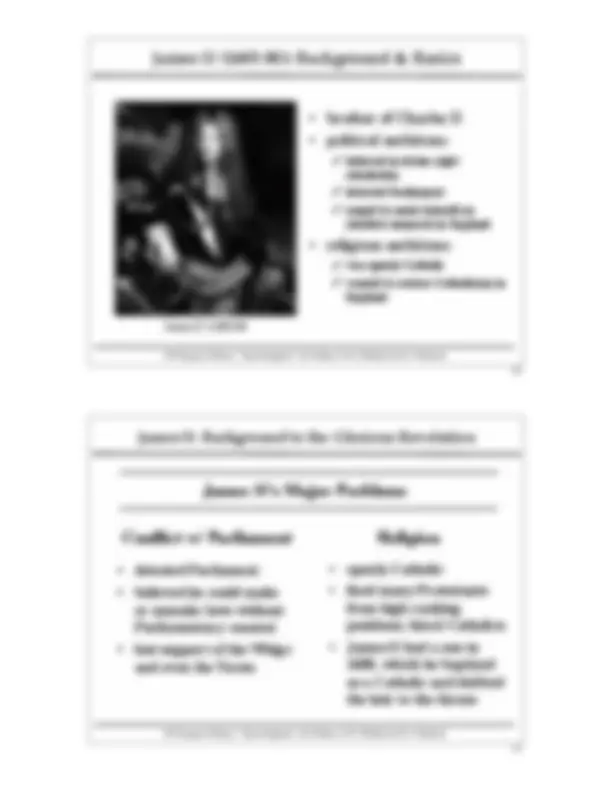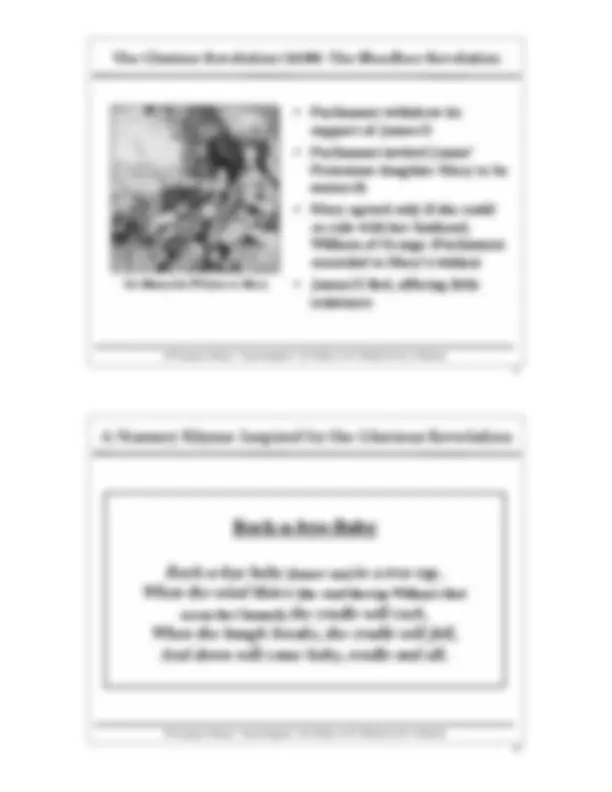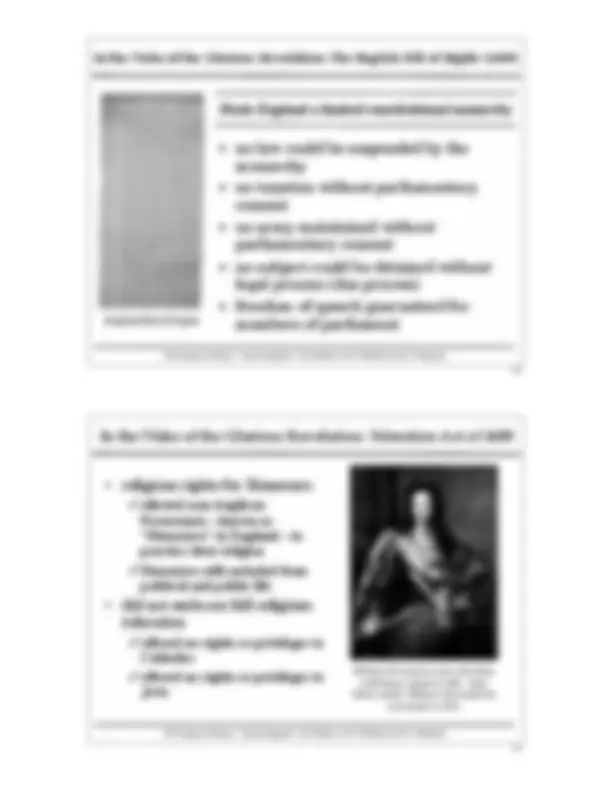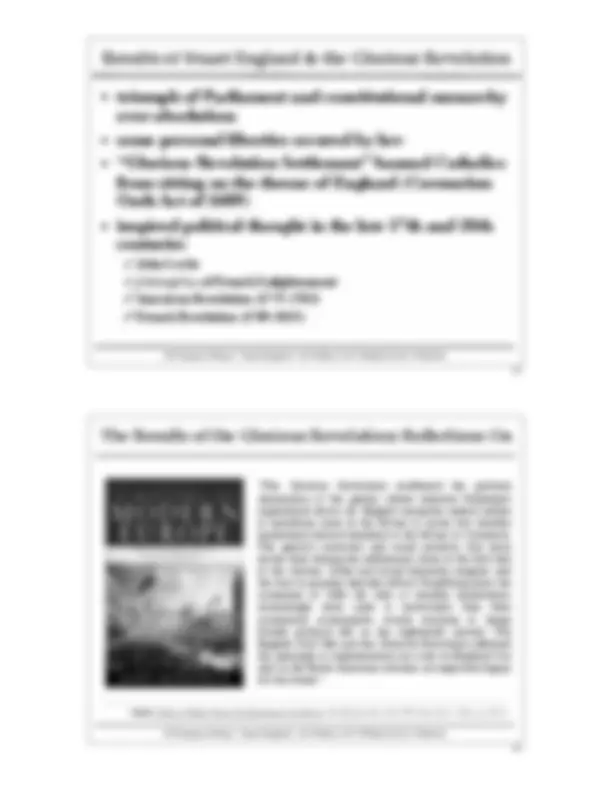Download Stuart England in the 17th Century and more Study Guides, Projects, Research European History in PDF only on Docsity!
Stuart England in the 17th Century
AP European History • Stuart England • J.F. Walters, G.W. Whitton & M.A. Prokosch 1
1. What was the nature of the conflict between the English kings and the parliament
in the 17th century?
2. What was the nature of the conflict within the Church of England in the 17th
century?
3. What happened to the English throne upon the death of Elizabeth I in 1603?
4. What were the guiding principles, developments and accomplishments of James I?
5. How did Charles I view his monarchy and the role of parliament in the English
government?
6. How did the Petition of the Right (1628) embody the spirit of the conflict between
Charles I and Parliament?
7. From 1629 to 1640, how did Charles I attempt to rule without calling Parliament?
Why did the period known as his “Personal Rule” end in 1640? How did the
conflict in Scotland contribute to the start of the English Civil War?
8. What were the nature and results of the English Civil War?
Stuart England in the 17th Century: Essential Questions (Page 1 of 2) AP European History • Stuart England • J.F. Walters, G.W. Whitton & M.A. Prokosch
9. Who was Oliver Cromwell? How did he rule England during the Commonwealth?
10. Why did the Commonwealth come to end in 1660? Upon its demise, who took
over the English government?
11. What were the major developments in England under the rule of Charles II?
12. How did James II view his monarchy and the role of parliament in the English
government?
13. What led to the Glorious Revolution? What did it mean for England?
14. Why did William of Orange want to rule England alongside James II’s daughter
Mary Stuart?
15. What were the results of the Glorious Revolution and its corresponding settlement?
Stuart England in the 17th Century: Essential Questions (Page 2 of 2) AP European History • Stuart England • J.F. Walters, G.W. Whitton & M.A. Prokosch 3
Elizabeth with Time and
Death looking over her
shoulder.
- “The Virgin Queen” Elizabeth died childless (she claimed she married England)
- Elizabeth was the last in Tudor dynasty
- closest heir was James Stuart of Scotland, who became James I of England End of Tudor England: Death of Elizabeth I (1603) AP European History • Stuart England • J.F. Walters, G.W. Whitton & M.A. Prokosch
- Scottish relative of Elizabeth I
- first in Stuart Dynasty
- Personal Union of Scotland and England: England and Scotland not one country, but both governed by same person
- justified his reign based on divine right ✓ believed he was God’s representative on Earth ✓ believed judges were agents of the king, not servants of the law ✓ Parliament rarely called when James I was in power James I: Background & Basics James I (1603-25) AP European History • Stuart England • J.F. Walters, G.W. Whitton & M.A. Prokosch 7 “The state of the Monarchy is the supremest thing upon Earth; for Kings are not only God’s lieutenants, and sit upon God’s throne, but even by God himself they are called Gods.” James I in a speech to Parliament (21 March 1609) James I: Divine Right Monarch AP European History • Stuart England • J.F. Walters, G.W. Whitton & M.A. Prokosch
Journal 19: Neither to James I nor to his son Charles I would Parliament grant
adequate revenue because it distrusted both.
––Palmer Chapter 19 • pp. 155-62–– Directions; Using sentences or detailed bulleted notes, identify & explain the evidence Palmer uses to support the thesis listed above. Stuart England: James I & Charles I AP European History • Stuart England • J.F. Walters, G.W. Whitton & M.A. Prokosch 9
- King James Bible--authorized publication of most famous English version of the Bible
- anonymously published True Law of Free Monarchies (1598), which argued a divine right monarchy is free from control of parliament
- wrote treatises on theology, witchcraft & tobacco use
- although James considered himself a scholar, others mocked him. One critic referred to James as “the wisest fool in Christendom.” James I: Scholar? AP European History • Stuart England • J.F. Walters, G.W. Whitton & M.A. Prokosch
- alienated Puritans by attempting to impose moderate Anglicanism on the Calvinist-leaning Puritans
- conflict with Parliament intensified throughout James’ reign ✓ over the appointment of James’ ministers ✓ over taxation and finances
- supported colonial settlements in North America ✓ Jamestown (1607) ✓ Massachusetts Bay (1620) James I: Major Developments James I: looking happy AP European History • Stuart England • J.F. Walters, G.W. Whitton & M.A. Prokosch 13 James I: The Gunpowder Plot (1605) AP European History • Stuart England • J.F. Walters, G.W. Whitton & M.A. Prokosch
• personal
✓ son of James I
✓ great supporter of the
arts
✓ known to be vain
• political
✓ believed in divine right
monarchy
✓ attempted to rule as an
absolute monarch
Charles I: Background & Basics
Charles I (1625-49) AP European History • Stuart England • J.F. Walters, G.W. Whitton & M.A. Prokosch 15
Charles I
Attempted to
rule with
Parliament
“Personal
Rule” without
Parliament
Conflict w/ Parliament intensified;
fought in parliamentary context
English Civil War
Charles’ trial and execution
Timeline
AP European History • Stuart England • J.F. Walters, G.W. Whitton & M.A. Prokosch
- Bishops’ Wars: Scottish revolts against Charles I ✓ Charles tried to impose the Anglican religion on Calvinist (Presbyterian) Scotland ✓ increased Scottish nationalism and infuriated English Puritans ✓ the impoverished Charles I could not muster an army suitable for crushing the revolt
- Charles recalled Parliament (1640) in hopes of financing an army to crush the revolt in Scotland Charles I: Revolt in Scotland (1640) Anthony van Dyck’s famous portrait of Charles I (1634) AP European History • Stuart England • J.F. Walters, G.W. Whitton & M.A. Prokosch 19
- Short Parliament (1640): met briefly but was quickly dissolved by Charles I
- Long Parliament (1640-1660) ✓ dominated by Puritans ✓ revolutionized the Church of England to make it more Presbyterian (Calvinist) ✓ issued “19 Propositions”: proposal for a new government relationship (a limited constitutional monarchy) ➡ (^) the king would have little power ➡ Parliament would exercise most governmental powers ➡ Charles could not––and did not––accept the 19 Propositions ‣ Charles raised an army ‣ Parliament raised an army
- Conflict elevated to civil war: the English Civil War Charles I: The Short & Long Parliaments AP European History • Stuart England • J.F. Walters, G.W. Whitton & M.A. Prokosch
“We should start with Charles I’s defense of [the] English monarchy, contained in his ‘Answer to the Nineteen Propositions of Parliament’ of 1642…He thought kings rule jure divino ; on his theocratic conception of kingship, the king received his authority from God, not the consent of subjects. The law of the land was the king’s law, subject to the enforcement or relaxation as he chose, Parliament was an advisory body that he might summon or not, and the citizens’ property was more deeply his than theirs. He should govern according to known and settled law, since God ruled the universe in a predicable, rational way; but the king’s authority was absolute, personal to himself, paternal and bequeathable.” Source : On Politics: A History of Political Thought from Hobbes to the Present, Alan Ryan (New York: Liveright Publishing Corporation, 2012), p. 503. Charles I’s Divine Right Justification: Reflections On AP European History • Stuart England • J.F. Walters, G.W. Whitton & M.A. Prokosch 21
According to political theorist Alan Ryan in his book On Politics: A History of Political
Thought from Hobbes to the Present, how did Charles I view Parliament’s “Nineteen
Propositions”? Explain.
Exam Skills (ES): Secondary Source Interpretation & Synthesis AP European History • Stuart England • J.F. Walters, G.W. Whitton & M.A. Prokosch
Humpty Dumpty Humpty Dumpty sat on a wall, Humpty Dumpty had a great fall. All the king’s horses and all the king’s men Couldn’t put Humpty together again. Nursery Rhyme Inspired by Charles’ Execution AP European History • Stuart England • J.F. Walters, G.W. Whitton & M.A. Prokosch 25
- republic: representative government with no hereditary monarchy
- Commonwealth initially was a government ruled by a noble- led Parliament
- Commonwealth eventually evolved into a military dictatorship ruled by Cromwell, the “Lord Protector”
Oliver Cromwell
The Commonwealth (1649-60): The Republic AP European History • Stuart England • J.F. Walters, G.W. Whitton & M.A. Prokosch
“Mr. Lely, I desire you would use all your skill to paint my picture truly like me, and not flatter me at all; but remark all these roughnesses, pimples, warts, and everything as you see me, otherwise I will never pay a farthing for it.” The Commonwealth (1649-60): The Republic Cromwell to an artist commissioned to paint his portrait AP European History • Stuart England • J.F. Walters, G.W. Whitton & M.A. Prokosch 27
- Cromwell in England ✓ established a strict, Puritan moral code and social climate ➡ (^) theaters were closed (the Globe Theater had been demolished by the Puritans in 1644) ➡ public drunkenness was outlawed ➡ (^) many sports were banned ➡ swearing could lead to fine or imprisonment ➡ women were not allowed to wear make-up ✓ Cromwell’s government grew increasingly unpopular
- Cromwell’s control of Ireland: Cromwell
detested the Irish
✓ England further entrenched control of Ireland by force: thousands of Irishmen were massacred and deported during the Commonwealth ✓ attempted to enforce Protestantism on Catholic Ireland ✓ English aristocrats took control of significant Irish land The Commonwealth (1649-60): The Republic Cromwell: not a popular man in Dublin AP European History • Stuart England • J.F. Walters, G.W. Whitton & M.A. Prokosch
- son of Charles I
- during Interregnum, spent time in court of Louis XIV
- ruled as a limited monarch ✓ Charles II understood the lesson of what happened to his father ✓ Charles’ reign would be marked by an active Parliament
- inaugurated “Restoration England” ✓ wild times socially ✓ flourishing of the arts
- many believed Charles was a closet Catholic Charles II: Background & Basics Charles II (1660-85) AP European History • Stuart England • J.F. Walters, G.W. Whitton & M.A. Prokosch 31 “From the start, Charles dated his reign not from the Restoration but from the death of his father, and firmly established that his regime was legitimate, its acts valid in law. In July 1660 an act confirmed that while the judgements of the courts under the Commonwealth on all private transactions should stand (thus embracing the courts’ decisions and the continuity of common law), no public acts––the statutes passed by parliament––were endorsed, because they never had the consent of the king. Cromwell’s legislation was thus simply wiped off the record as illegal. In terms of legislation, Charles and his parliament were transported back in time, to 1641. This return to the status quo of nineteen years before meant that all the radical changes that Cromwell’s parliament had made in the way the kingdom was governed were swept away….” Source: A Gambling Man: Charles II’s Restoration Game, Jenny Uglow (New York: Farrar, Straus and Giroux, 2009), pp. 76-77. The Restoration of Stuart England: Reflections On AP European History • Stuart England • J.F. Walters, G.W. Whitton & M.A. Prokosch
In her book A Gambling Man: Charles II’s Restoration Game, by what justification does
historian Jenny Uglow argue Charles II was able to invalidate the changes that had been
made under Oliver Cromwell? Based on your study of history thus far, what reforms of
the Cromwell era were likely invalidated by Charles II’s restoration?
Exam Skills (ES): Secondary Source Interpretation & Synthesis
Charles II’s justification for
removing reforms of Cromwell era
‘s
Cromwell reforms invalidated by Charles II
AP European History • Stuart England • J.F. Walters, G.W. Whitton & M.A. Prokosch 33
- Corporation Act (1660): to be a justice of peace, one had to participate in Church of England (COE) services.
- Test Act (1673): all holders of political offices must take sacrament in COE.
- Habeas Corpus Act (1679): protection from arbitrary arrest and safeguarding of personal liberties. Charles II: Acts Passed by Parliament AP European History • Stuart England • J.F. Walters, G.W. Whitton & M.A. Prokosch
St. Paul’s Cathedral
Charles II: Christopher Wren & the Rebuilding of London AP European History • Stuart England • J.F. Walters, G.W. Whitton & M.A. Prokosch 37
Journal 20: Not long after the Restoration, Parliament and king were at odds. The
issue was again religion.
––Palmer Chapter 20 • pp. 162-69–– Directions; Using sentences or detailed bulleted notes, identify & explain the evidence Palmer uses to support the thesis listed above. Stuart England: Charles II & James II AP European History • Stuart England • J.F. Walters, G.W. Whitton & M.A. Prokosch
- brother of Charles II
- political ambitions ✓ believed in divine right absolutism ✓ detested Parliament ✓ sought to make himself an absolute monarch in England
- religious ambitions ✓ was openly Catholic ✓ wanted to restore Catholicism in England James II (1685-88): Background & Basics James II (1685-88) AP European History • Stuart England • J.F. Walters, G.W. Whitton & M.A. Prokosch 39
- detested Parliament
- believed he could make or unmake laws without Parliamentary consent
- lost support of the Whigs and even the Tories James II’s Major Problems Conflict w/ Parliament Religion
- openly Catholic
- fired many Protestants from high ranking positions; hired Catholics
- James II had a son in 1688, which he baptized as a Catholic and dubbed the heir to the throne James II: Background to the Glorious Revolution AP European History • Stuart England • J.F. Walters, G.W. Whitton & M.A. Prokosch

